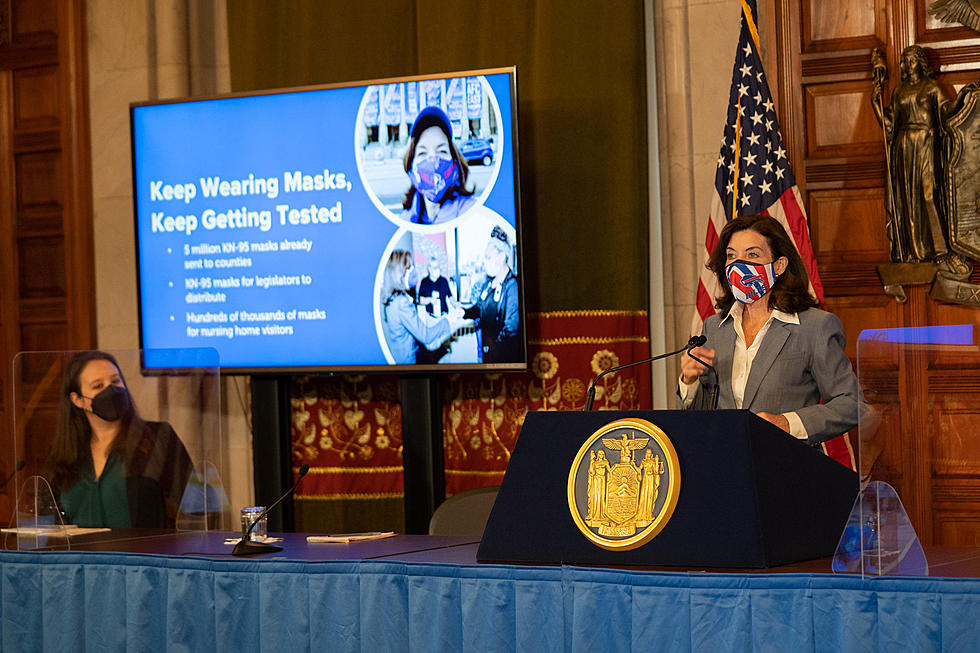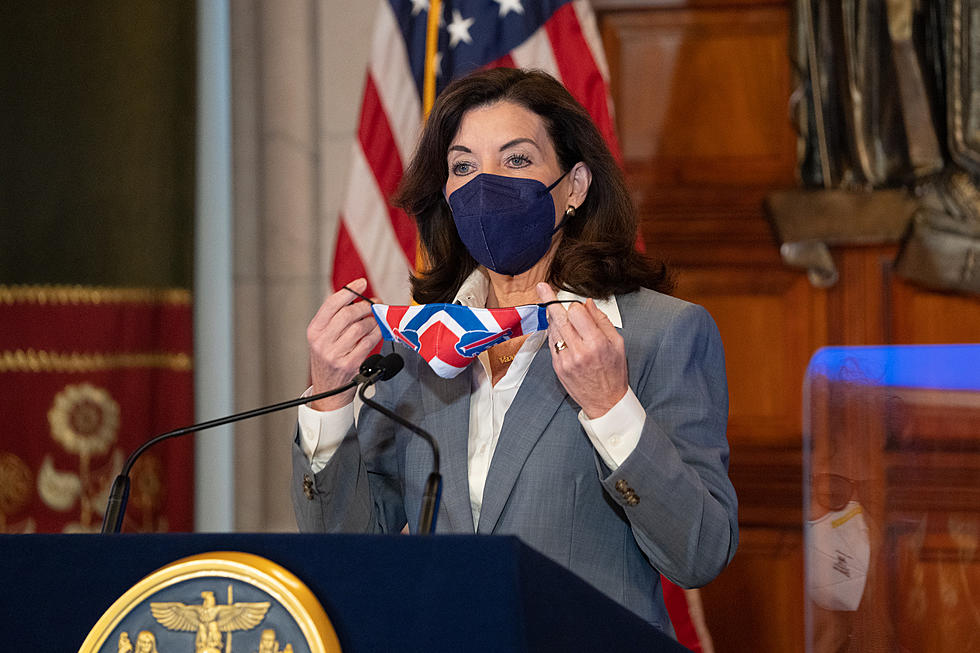
With COVID Cases Soaring in New York Governor Issues New Rules
New York leaders are trying to slow the spread of COVID as the transmission rate reaches numbers not seen since April.
Over the weekend, Gov. Kathy Hochul announced three more confirmed cases of the COVID-19 Omicron variant in New York State, for a total of eight confirmed cases.

"Let me be clear: this is not cause for alarm, we knew this variant was coming and we expect to see more cases," Hochul said. "I want to remind all New Yorkers to use the tools they have at their disposal to keep themselves and their communities safe: get your vaccine, get your booster, and wear your mask. We will get through this."
So far, the cases appear unrelated and have been confirmed through sequencing of the SARS-CoV-2 virus. All three of the new cases are from New York City, for a total of seven New York City residents and one from Suffolk County confirmed to have the Omicron variant.
"We knew the Omicron variant was coming and we expect to see more cases. But let me be clear: We are not defenseless," Governor Hochul said. "We have the tools to help prevent the spread of this deadly virus: Get your vaccine, get your booster, and wear your mask. Let's use these tools to protect ourselves and our loved ones as we approach the holidays."
The Governor and the Department of Health also released written guidance on Executive Order No. 11, which enables the Department to protect access to critical health care services by limiting non-essential, non-urgent procedures at certain hospitals currently experiencing limited capacity.
New York is now experiencing COVID-19 transmission at rates the state has not seen since April 2021, and the rate of new COVID-19 hospital admissions has been increasing over the past month to over 300 new admissions a day. In consideration of this emergent risk and the capacity constraints in certain New York regions/facilities last winter, the State is pursuing a coordinated, collaborative approach to ensure hospital capacity meets regional needs while maintaining the long-term resiliency of the State’s healthcare infrastructure.
The framework below details when facilities must, upon DOH review and determination, limit non-essential elective procedures and/or implement other actions to coordinate services as determined by DOH to ensure New York State (“NYS”) health systems and hospitals can address potential capacity constraints.
Assessment
The assessment below will be used on a weekly basis to determine the Impacted Facilities List.
1. High-risk regional assessment (defined as “High-Risk Regions”):
• Low current regional capacity: Staffed acute bed occupancy rate for the region at
[90%] or higher (based on the previous 7-day average); OR
• Decreasing current regional capacity: Staffed acute bed occupancy rate for the
the region at [85-90%] (based on the previous 7-day average) AND New COVID-19
hospital admission rate for the region (previous 7-day average per 100,000
population) is greater than [4.0].
If criteria is met in #1, then the facility-level risk assessment will be completed.
2. Facility-level risk assessment:
• Low current facility capacity: Staffed acute bed occupancy rate for the facility at
[90%] or higher (based on the previous 7-day average).
Relevant types of procedures
Impacted Facilities may be required to limit non-essential elective procedures both within the hospital and at hospital-owned ambulatory surgery centers, depending upon the qualifying criteria below.
DOH determination, and the following qualifying criteria:
1. An Impacted Facility must defer all non-essential elective in-patient and out-patient
procedures that are completed within the hospital.
2. An Impacted Facility with occupancy of [95% or higher] (based on the previous 7-day
average) must also defer non-essential elective ambulatory procedures.
The following procedures are considered essential and not covered under this DAL:
- Cancer, including diagnostic procedure of suspected cancer
- Neurosurgery
- Intractable Pain
- Highly symptomatic patients
- Transplants
- Trauma
- Cardiac with symptoms
- Limb threatening vascular procedures
- Dialysis Vascular Access
- Patients that are at a clinically high risk of harm if their procedures are not completed
Operationalization of the policy
1. Monitoring/compliance:
• All facilities will be monitored and required to continue submitting capacity and
occupancy data through HERDS daily.
• DOH will determine Impacted Facilities weekly; these facilities must defer nonessential elective procedures in accordance with DOH determination for [at least
2 weeks].
i. This framework will be effective [Friday] December 3rd. The first round of
determinations will be issued to facilities by [Monday] December 6th, to
apply to procedures scheduled to occur on or after [Thursday] December
9th.
ii. Beginning the week of [Monday] December 13th, [Wednesday] data will be
reviewed by DOH on [Thursday] and Impacted Facilities will be notified on
[Friday]; procedure limitations will take effect the following [Thursday].
2. Regional coordination for High-Risk Regions:
• All hospitals (regardless of whether they meet the criteria of Impacted Facility)
should participate in regional coordination calls. Upon weekly assessment, DOH
will notify regions of any changes in their risk level.
• All hospitals should implement load balancing within their system provided they
do not transfer patients outside of their systems for the sole purpose of meeting
the capacity threshold (although transfers out of trauma hospitals for the purpose
of reducing ICU occupancy are permitted).
• All hospitals should accept safe transfers in accordance with usual practices,
unless as directed by DOH.
3. Exceptions and DOH discretion
• Criteria for determining High-Risk Regions and Impacted Facilities are subject to
change and will be reviewed on an ongoing basis by DOH; any updates will go
into effect by the next reporting cycle.
While this order is effective now, determinations will be issued to facilities by December 6 to apply to procedures scheduled to occur on or after December 9.
Answers to 25 common COVID-19 vaccine questions
Nearly a Dozen New York Supermarkets Forced to Close
Photos: Fire in Hudson Valley Destroys Historic New York Resort
Over 1 Foot of Surprise Snow Shocks Parts of Hudson Valley, New York State
LOOK: 50 famous memes and what they mean
Bill Murray Stuns New York Fans By Showing Up At West Point
Unacceptable New York Roads Costing Drivers Insane Amount of Money
40 High-Risk Hudson Valley Sex Offenders Recently Moved in New York State
Over 50 New York Pizzerias Ranked by Barstool's Dave Portnoy
20 Worst Places to Live in New York State
Barstool's Dave Portnoy Finally Reviews Pizza From Mid-Hudson Valley
Potential Cancer-Causing Chemicals Found in New York Drinking Water
The 26 Most Dangerous Counties in New York State
15 New York Towns Among Safest in America
Top 5 Best Places to Live in New York
Election Results: New York Voters Approve, Deny Major Changes
Hudson Valley Says Goodbye To Over 80 Businesses
Nearly 70 Children Have Recently Gone Missing From New York State
Counties in New York With Most Vehicle vs. Animal Crashes
9 New Fast Food Restaurants Coming to Route 9
Over 30 Red Flags For Anyone Who Claims To Live in Hudson Valley, NY
Hudson Valley Welcomes Nearly 70 New Eateries
5 New York Schools Districts Ranked in Top 10 in America
New York Counties With Highest, Lowest COVID Vaccine Rates
'Hudson Valley's Premier Restaurant, Bar' Opening Newburgh Waterfront Location
All-Time COVID Cases Per County in New York
Air-Breathing Fish That Eats Animals Found in Hudson Valley, New York
More From 96.1 The Eagle









